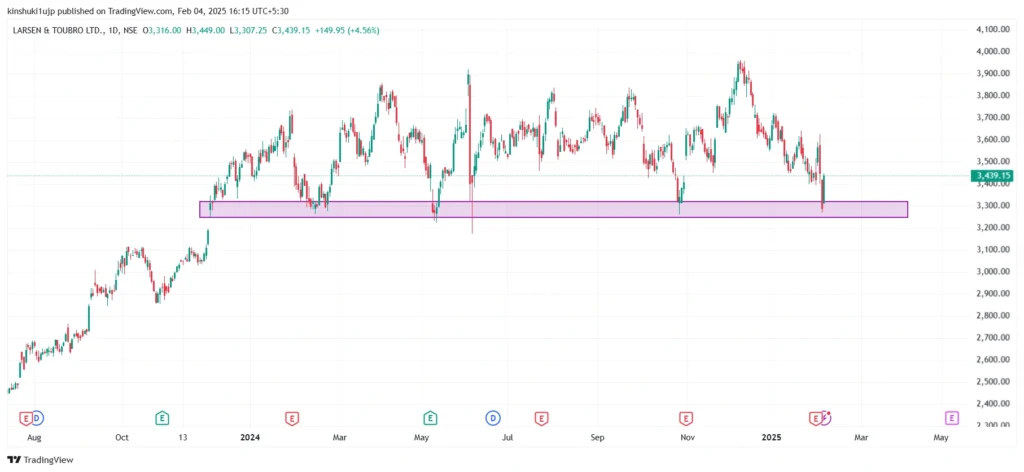Explore the step by step process of understanding the stock markets using Technical Analysis for beginners in this blog.
The study of the movement of the price of a stock or a stock market index is a technical analysis. Some market participants use technical analysis to study and find the overall direction in the long term whereas, some use it for short-term trading purposes.
This blog intends to highlight how to use Technical Analysis to study the long-term price direction and movement of stock markets for beginners.
Market Behaviour Using Technical Analysis
In easy words, it is important to first understand the direction of the price move and then to see whether the price is entering any possible buying and selling zone. It is important to understand if the move in prices is supported by good volumes or not. Here’s the step-by-step technical analysis for beginners:
Step 1: Trend Indendification
The most important aspect of price in technical analysis is a trend. Trend refers to the direction in which the price moves. Prices can move either downwards, upwards, or sideways. Identifying the direction of price action is of utmost importance in stock market analysis.
- Uptrend: Uptrend means prices are moving in a series of higher lows and higher highs. It means each price high and each price low is higher than the previous one. As you can see in the daily chart of Gold Futures below, green upward arrows mark the higher lows, each price low is higher than the previous one, and red downward arrows mark the higher highs. This shows the Gold Futures are in an uptrend.

Source: Tradingview (Gold Futures, Daily)
- Downtrend: Downtrend refers to prices making a series of lower highs and lower lows. Here, each new price low and each new price high is lower than the previous one. For example, as you can see in the stock chart of BHEL, prices are making lower highs (red downward arrows) and lower lows (green upward arrows). This is a classic downtrend.

Source: Tradingview (BHEL, Daily)
- Sideways: A sideways or range-bound price action is when the prices are neither moving upwards nor downwards. In such a case, prices make equal highs and equal lows. For example, you can see the daily chart of Bitcoin, which shows sideways movement.

Source: Tradingview (Bitcoin, Daily)
A line can be used to connect the higher low points in an uptrend, and similarly, a line can be used to connect the lower highs in a downtrend. This line is called a trendline.
Step 2: Support and Resistance
When the price action is heading upward, they enter a zone where there are a huge number of sellers present. Those sellers make it difficult for the prices to go beyond these sell zones. These zones are called resistance zones. Prices of a stock often face difficulty crossing these resistance zones. For example, if you look at the daily chart of the Nifty healthcare index, you can see that the index has twice retreated from the 14,800 – 15,000 zone (marked in purple). Next time when the index reaches this level, it can face some resistance.

Source: Tradingview (Nifty Healthcare Index, Daily)
When the prices reach a zone where there are a huge number of buyers present, it is known as a support zone. The falling prices usually take a breather in a support zone.
For example, looking at the stock chart of Larsen and Toubro Ltd, you can see the prices are not breaking below the 3250 – 3320 level (purple zone). The prices take support at these levels and reverse. This is a support zone.

Source: Tradingview (L&T, Daily)
Always remember that when the price moves above a resistance zone, it becomes the new support zone. When prices break below the support zone, it becomes the new resistance level.
Step 3: Volume
Technical Analysis is incomplete without volume analysis. Volume refers to the number of shares that changed hands in a given period of time. When a price moves in a certain direction accompanied by volume, it is a sign that the price is moving because a large number of shares are being traded.
It generally means that the positions are being taken by large institutional trades. This confirms that the big players or smart money believes that the price will continue its move in that direction.
For example, on 21st Feb 2024, on the daily stock chart of ABB ltd, price closed 10% higher with a volume of 4.4 million shares traded. This meant that an institution might have taken a big position in this stock. The stock saw a significant upside after that.

Source: Tradingview (ABB Ltd, Daily)
A good volume should be used as a confirmation or rejection signal of the main signal and not an indicator in itself.
Low volume can be used for rejection of a breakout, and good volume can be used for confirmation of a breakout.
Step 4: Indicators
Trades use various indicators like the Relative Strength Index, or RSI, and the Moving Average Convergence Divergence Indicators, or MACD. These indicators are used for finding reversal and confirmation signals for the price. Some indicators are overlaid on the chart whereas some are placed in a separate pane below the main stock chart
Traders use various methods to analyze these indicators, and the most common method for using these indicators is identifying overbought and oversold zones.
These zones indicate a possible reversal for prices, and trades can plan to book profits once the prices enter these zones.
There are hundreds of such indicators available, and beginners can learn each one of them slowly with experience.
Step 5: Risk management
Risk management is a method of minimizing your risk. There are many ways of measuring and reducing the risk. Risk management is important for both trading and investment. Beginners must focus on learning the most common methods of risk management, which are:
- Stop loss: A stop loss is a price at which the stocks are sold automatically. This helps in limiting your risk to a certain extent. Beginners must learn to use stop-loss orders from the very beginning.
- Position Sizing: Position sizing means how many shares should you buy considering your total capital and risk associated with a particular trade. A general rule of risk management is that you shall not risk more than 5-10% of your capital in a single trade.
Conclusion
A beginner should focus on these five steps to learn to identify the price action or behaviour of markets. Although there are many advanced indicators and stock chart patterns, these are good first steps for people who are beginners in the field of technical analysis. You can view hundreds of stock charts to identify trends, support/ resistance zones, and volumes. This charting software also allows you to place any number of indicators on the screen. Remember that beginners should not use real money when they start learning. It is advisable to trade on paper in your learning stages.
DISCLAIMER: The information given in this blog is for educational purposes only. Any content of this blog is not investment advice.
- Weekly Nifty 50 Trading Strategies and Technical Outlook - June 11, 2025
- Nifty 50 Trading Strategies and Technical Analysis - May 26, 2025
- Weekly Nifty 50 Technical Analysis: Key Trading Strategies - April 30, 2025





